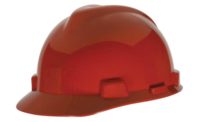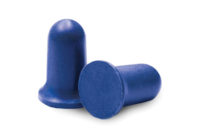
Thanks to advances in safety, the hard hat has evolved over the decades. There have been many improvements in the last decade, but the story began almost 100 years ago.
The “Hard-Boiled Hat,” patented in 1919, was so called because of the steam used in the manufacturing process. The original “Hard-Boiled Hat” was manufactured of steamed canvas, glue and black paint. North America’s first application was the San Francisco Golden Gate Bridge construction site. This workplace had a problem with falling rivets, so it is understandable that head protection became necessary.
We have now evolved from those days of primitive materials and no standards to having 21st Century design and materials and an organization like ANSI helps to bring us to the next level.
Key issues
When selecting head protection equipment, it’s important to choose a well-designed hard hat system. Comfort and adjustability are key issues to consider as buyers evaluate designs. You’ll find many features available that are not specified in the ANSI Z89 1-2009 standard; features that are important when wearing a hard hat for several hours a day, five days a week.
What's new?
The latest hard hat system is properly designed and integrates all components to insure worker safety, high performance and comfort. Advances in design include a recessed rim, which allows for a proper fit over the ears. This design improves fit for cap-mounted muffs. When you have a better fit, you have improved protection.
Adjustability
Look for brands of hard hats that have built-in adjustability for a head-hugging fit and slots for adapting accessories. Accessories called slot adaptor or “blades” fit into slots, to combine a visor (face shield) with or without cap-mounted ear muffs. This allows the user to adjust the position of the face shield closer to, or further from, their face. It also positions the shield in front of the face or overhead when not required.
A well-designed system allows the worker to adjust the cap muffs in a number of ways. Muffs can be positioned vertically up and down to fit comfortably over the ears. Muffs can be positioned on standby, by folding the muffs out and positioning them on top of the hard hat, available for future use. This integrated system is an excellent option, allowing easy access to shield and muffs when entering a hazardous environment. Ease of adjustability improves comfort and performance in the following ways:
- A head-hugging suspension can be vital for workers angling their head or working in a leaning position. Hard hats should provide for height adjustability of the headband. In some designs, a rear swivel band insures adjustability to the shape of back of the head. Together these features increase comfort and help users find the best position for a snug fit.
- Slot adaptors (blades) should have channels with position stops for moving a face shield close to, or further from, the face. This prevents fogging and is critical when wearing face masks.
- Visor brackets should have strong springs to hold the shield firmly in position when overhead. No one wants a shield flopping up and down while walking.
- Utilizing system components made of non-metal provides adjustability, with dielectric construction.
- Hard hats that have recesses in the rim allow ear muffs to slide up and down easily without restricting fit, performance and comfort.
Classes of industrial protective headwear
The ANSI standard also covers dielectric properties. To qualify for a Class E rating (electric), manufacturers must also ensure that the materials used to make a hard hat — both the shell and the suspension — be dielectric, as a hat must pass an electrical test that protects up to 20,000 volts. For a Class G rating (general purpose) the conductivity test must qualify with a protection limit of 2,200 volts. Lastly, a Class C rating is a hard hat manufactured of conductive material, or a hard hat that does not meet Classes E or G. This would only be suitable in areas where there is no risk of electrical hazards.
Hard hat maintenance
An often-overlooked area in many articles of personal protective equipment (PPE) is maintenance. Hard hats are no exception and must be maintained. A dirty hat covers up small cracks and is very difficult to inspect. Too many workers don’t read the manufacturer’s instructions and don’t maintain their hard hats. Hard hats are some of the most important PPE that workers wear. They are lifesaving devices and should be treated as such.
A hard hat system that is properly designed and integrates all components will insure worker safety, high performance and comfort.


